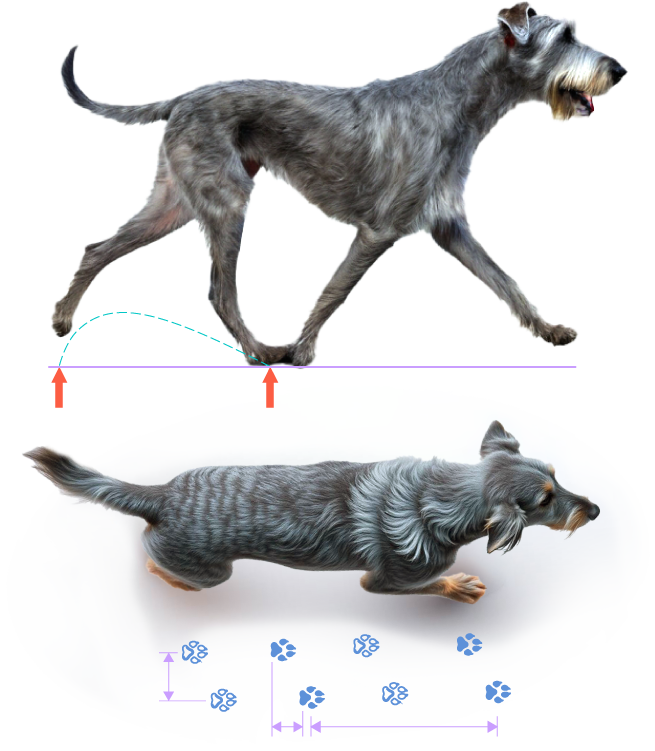
Because movement means life – rethinking gait analysis
Detect the smallest changes at an early stage and enable dogs to live a pain-free life.
Gait analysis & kinematics
How movement patterns are analyzed
Why is a gait analysis essential?
A dog’s movement is a complex interplay of joints, muscles, tendons and the nervous system. Every step requires precise coordination of these structures to enable a harmonious and efficient gait. Even the smallest deviations or asymmetries in movement can be the first signs of pain, incorrect loading or degenerative diseases. While pronounced lameness is often visible to the naked eye, subtle changes in movement often go unnoticed, especially in the early stages. Without an objective analysis, it is difficult to distinguish between normal individual movement patterns and pathological changes.
Precise gait analysis provides measurable data that enables early detection of movement problems before they manifest clinically. This is crucial for targeted therapy and sustainable prevention. For orthopaedic and neurological conditions in particular, a detailed analysis can help to identify incorrect loading or structural changes before they lead to pain or functional limitations.
Continuous movement analysis also allows a well-founded assessment of the healing process and targeted adaptation of therapy in rehabilitation after injuries or operations.
A purely visual assessment of the gait pattern is often not sufficient, as subtle deviations are difficult to recognize and the examiner’s perception can be influenced. In particular, bilateral lameness or changes that only become apparent under stress often remain undetected. An objective gait analysis makes it possible to measure the smallest changes in step frequency, joint angles or load distribution and provide reproducible results that support sound treatment planning.
The use of modern gait analysis systems adds a crucial component to veterinary diagnostics. The early identification of movement restrictions helps to prevent pain, initiate targeted therapeutic measures and improve the mobility and quality of life of dogs in the long term.
Basics of kinematics in gait analysis
Kinematics describes the movement of bodies in space without considering the forces at work. In veterinary gait analysis, this means
- Measurement of stride lengths, joint angles and stride frequencies
- Assessment of symmetry between the left and right side of the body
- Analysis of the load distribution on the limbs
These factors provide scientifically sound data that can be used for diagnostics, therapy planning and follow-up.
How does a gait analysis work? – A comparison
1. Visual gait analysis
Subjective assessment by the veterinarian
Visual gait analysis is based on the veterinarian’s subjective observation of the movement sequence. Aspects such as lameness, irregularities in the gait pattern, abnormalities in posture or weight transfer as well as changes in stride length or frequency are assessed. As this assessment is based on the individual perception of the examiner, there may be differences in interpretation.
Visual assessment is often not sufficiently accurate, particularly in the case of bilateral lameness or subtle gait abnormalities. Studies show that even experienced examiners reach their limits when assessing minor deviations in movement.
Without objective measurement data, it can therefore be difficult to distinguish between normal individual movement patterns and pathological changes.
2. Objective gait analysis with sensors
Scientifically sound diagnostics
In contrast, objective gait analysis with systems such as LupoGait enables precise, reproducible and scientifically sound recording of movement parameters. By using high-precision sensors attached to the dog, detailed biomechanical data can be measured in real time.
LupoGait analyzes up to 34 different gait parameters, including step frequency, joint angle changes, symmetry of movement and load distribution. This objective data makes it possible to detect even the smallest abnormalities at an early stage and initiate targeted therapeutic or preventive measures.
As objective gait analysis does not depend on the individual perception of the examiner, measurements can be standardized and compared across different points in time. This makes it particularly valuable for the diagnosis of orthopaedic and neurological diseases as well as for long-term follow-up in rehabilitation.

